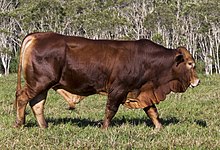
Summary
The Droughtmaster is an Australian breed of beef cattle. It was developed from about 1915 in North Queensland by crossing zebuine cattle with cattle of British origin, principally the Beef Shorthorn. It was the first Australian taurindicine hybrid breed;[3]: 171 it is approximately 50% Bos indicus and 50% Bos taurus.[4]
 A young bull | |
| Conservation status | |
|---|---|
| Country of origin | Australia |
| Standard | Droughtmaster Stud Breeders' Society |
| Use | beef |
| Traits | |
| Weight | |
| Height | |
| Horn status | horned or polled |
| |
History edit
The Droughtmaster was developed from about 1915 in North Queensland by crossing zebuine cattle with cattle of British origin, principally the Beef Shorthorn. Other British breeds, mainly Hereford, were later used. Much of the development was done by one breeder, R.L. Atkinson.[5]
In 1956 breeders decided to focus on red cattle only; the Droughtmaster name proposed by Atkinson was adopted. A breed society, the Droughtmaster Stud Breeders' Society, was formed, and a herd-book was started.[6]: 721 [5]
From 1969, five Droughtmaster bulls were used for cross-breeding with the local Bhagnari in the Baluchistan province of Pakistan, leading to the creation of the Nari Droughtmaster.[6]: 405 It has also been exported to other countries, among them New Guinea, Nigeria, Samoa and Taiwan.[3]: 171 [4]
Characteristics edit
Droughtmasters have good walking and foraging abilities, coupled with lower nutritional requirements to give them the ability to retain condition and keep breeding, irrespective of the prevailing conditions. Their short coat is generally red in colour, although variations from golden honey to dark red can occur. The red pigmentation in Droughtmasters helps protect the cattle from cancer eye, sunburnt udders and photosensitisation. The cattle may be either horned or polled; the majority are polled and exhibit only a moderate hump. They have an extended dewlap.
Use edit
It is a beef breed, and is reared particularly in areas with a high incidence of drought, heat, tick-borne disease and sun damage.[7]
References edit
- ^ Barbara Rischkowsky, Dafydd Pilling (editors) (2007). List of breeds documented in the Global Databank for Animal Genetic Resources, annex to The State of the World's Animal Genetic Resources for Food and Agriculture. Rome: Commission on Genetic Resources for Food and Agriculture, Food and Agriculture Organization of the United Nations. ISBN 9789251057629. Archived 23 June 2020.
- ^ a b c d e Breed data sheet: Droughtmaster / Australia (Cattle). Domestic Animal Diversity Information System of the Food and Agriculture Organization of the United Nations. Accessed July 2021.
- ^ a b Valerie Porter, Lawrence Alderson, Stephen J.G. Hall, D. Phillip Sponenberg (2016). Mason's World Encyclopedia of Livestock Breeds and Breeding (sixth edition). Wallingford: CABI. ISBN 9781780647944.
- ^ a b Cattle breeds: Droughtmaster. New South Wales Department of Primary Industries. Archived 19 March 2016.
- ^ a b [s.n.] (24 November 2012). Droughties: bred for the north. North Queensland Register. Archived 11 March 2021.
- ^ a b Marleen Felius (1995). Cattle Breeds: An Encyclopedia. Doetinchem, Netherlands: Misset. ISBN 9789054390176.
- ^ Breed history. Droughtmaster Stud Breeders' Society. Archived 11 March 2021.
Further reading edit
- Stephens, M (et al.), Handbook of Australian Livestock, Australian Meat & Livestock Export Corporation, 2000 (4th ed), ISBN 1-74036-216-0


